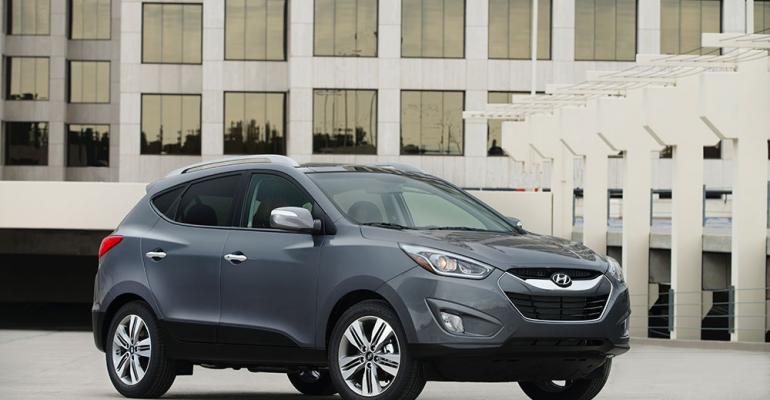DETROIT – Hyundai is counting on increased CUV volume to help restore lost market share in the U.S., a top company official says.
Hyundai achieved 5.0% U.S. share in 2011, but last year its slice of the market fell to 4.6%.
“As we talk with our parent (company) on how we drive and really get back to 4.7%, 4.8%, 4.9%, 5.0% market share, the CUV business is a critical part of that discussion,” Dave Zuchowski, president and CEO-Hyundai Motor America, tells WardsAuto here.
“You look at Honda’s mix of CUVs vs. cars, you look at Subaru’s mix of what is driving Subaru’s growth and you look at our mix and it’s very clear (CUV) can be a bigger piece of our growth than it has been in the past,” he says.
Hyundai became a midsize-sedan contender in the U.S. with the launch four years ago of a redesigned Sonata. A year later, it repeated that success with a well-received new-generation Elantra compact car.
But breaking into the CUV segment hasn’t been as easy.
While Hyundai is seeing moderate success with its Santa Fe midsize CUV, redesigned a year ago, it continues to fall short of its goals for car-based utilities as a whole.
“We really do well on the car side of the business, and we really underperform on the (light)-truck side of the business,” Zuchowski says. “We haven’t had the entries and the capacity to grow our share on the truck side, which is where the growth has been.”
The CUV segment was one the fastest-growing new-vehicle groups last year, up 15.5%, WardsAuto data shows, with sales of Small CUVs up 34.7%, Middle CUVs climbing 11.5% and Large CUV deliveries rising 37.3%.
While Hyundai enjoyed a 25.1% increase in Santa Fe demand in 2013, selling 88,844, the U.S. CEO believes the brand easily could deliver 150,000 Santa Fes annually.
However, Hyundai’s capacity crunch have kept a lid on volume.
“Production volumes are fairly fixed…at about 30,000 long-wheelbase (Santa Fes) and 75,000 short-wheelbase (Santa Fe Sports),” Zuchowski says.
As Hyundai establishes plants in emerging markets, such as the Czech Republic, China and Brazil, it will free up capacity in South Korea for more Santa Fes and other Hyundai models in high demand, he says.
The Korean automaker assembles three models in the U.S., the Sonata and Elantra in Montgomery, AL, and the Santa Fe Sport model in West Point, GA, but it still imports about half its annual U.S. volume from overseas plants.
“Because we’ve been short on what I would call people-mover capability, we think there’s more upside on the 7-passenger (Santa Fe), and we’re talking closely with (our parent) to try and get more global capacity,” Zuchowski says.
“If you look at the segments in the U.S. vs. segments in some of these other emerging markets, there’s not nearly the demand there is in the U.S. for some of those fullsize vehicles, (so) we’ve been successful this year in getting some additional production of (the) 7-passenger (Santa Fe).”
The new Hyundai U.S. president also is eagerly anticipating the next generation of the brand’s smaller CUV, which WardsAuto forecasts will debut this year.
Last redesigned in ’10, the Tucson hasn’t made as big a dent in the ultra-competitive entry CUV segment as Hyundai hoped.
Most small CUVs sell more than 100,000 units annually, including Honda’s CR-V, which last year repeated as the top-selling small CUV in the U.S., with 303,904 sales.
Tucson deliveries fell 14.3% in 2013 to 41,906, placing it third-to-last in volume, ahead of sister-brand Kia’s Sportage (32,965) and Volkswagen’s Tiguan (30,002).
“I think Tucson is such a great product, and ever since we announced it, we’ve never had enough,” Zuchowski says. “And because we’ve never had enough, we’ve never really put any advertising support against it or any incentive support against it.”
Hyundai U.S. dealers have been unhappy with a 40-day supply level of the vehicle, and the next-generation Tucson, due in 2015, “absolutely” will receive a bigger marketing push, he says.





